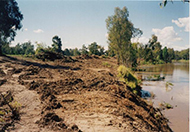
Priorities Action Statement - Degradation of native riparian vegetation along NSW water courses
Threat Abatement Actions
Advice to consent and determining authorities
- Provide local councils, agencies and Local Land Services (LLSs) with resource material (impact assessment guidelines, mitigating prescriptions, offsets, and generic consent conditions) regarding large woody debris to support planning, determination, impact assessment and concurrence decision making processes (Medium priority).
- Consult with relevant public authorities and local councils to determine the extent, rates and reasons for riparian vegetation removal, either authorised or undertaken illegally (Medium priority).
Collate and review existing information
- Review and amend riparian vegetation management actions in response to monitoring results (High priority).
- Review existing literature and integrate research and investigation results to develop best practice guidelines for riparian revegetation activities (High priority).
- Review existing legislation, policies and strategies in relation to riparian vegetation management in NSW and identify gaps and weaknesses in current legislation and policy. Implement actions to address identified weaknesses (Medium priority).
Community and stakeholder liaison, awareness and education
- Develop and disseminate educational materials regarding best practice riparian vegetation management through media, NSW DPI website, community networks, extension officers, LLSs and local councils (Medium priority).
- Publicly promote rehabilitation programs to raise awareness of the role and importance of riparian vegetation in the broader community, and levels of community interest (Low priority).
Compliance / enforcement
- Review reports and investigations of illegal riparian vegetation clearing, and consult with relevant public authorities and local councils to determine the extent, rates and reasons for riparian vegetation removal authorised by relevant NSW legislation (Medium priority).
Enhance, modify or implement NRM planning processes to minimize adverse impacts on threatened species
- Incorporate knowledge gathered from riparian vegetation orientated research programs into recovery and threat abatement actions for threatened species, populations and ecological communities (High priority).
- Ensure the development, administration and implementation of legislative and policy frameworks to protect riparian vegetation. This includes development consents, State Environmental Planning Policies, property vegetation plans, private native forestry codes of practice, native vegetation regulations, integrated forest operations approvals, and forest operating procedures (Medium priority).
Habitat protection
- Identify options to utilise regulatory and voluntary incentive based mechanisms to protect riparian vegetation in priority areas known to support threatened species, populations or ecological communities and implement as appropriate (Medium priority).
Habitat rehabilitation
- Actively seek funding for reinstatement programs in priority and degraded areas having regard to PAS actions and approved recovery and threat abatement plans (High priority).
- Develop a prioritised riparian vegetation and restoration program for NSW rivers and rehabilitate degraded areas in accordance with identified priorities (High priority).
Research / monitoring
- Develop and implement research programs to address key knowledge gaps of the ecological interactions between riparian vegetation and threatened species, populations and ecological communities (High priority).
- Monitor the response of aquatic ecological communities to riparian vegetation rehabilitation programs (Medium priority).
- Develop and implement a targeted investigation program to determine the reasons, extent and rates of riparian vegetation removal and degradation across NSW (Medium priority).
Survey / mapping
- Undertake detailed survey and mapping work to establish the historical and current distribution of riparian vegetation in NSW (High priority).


